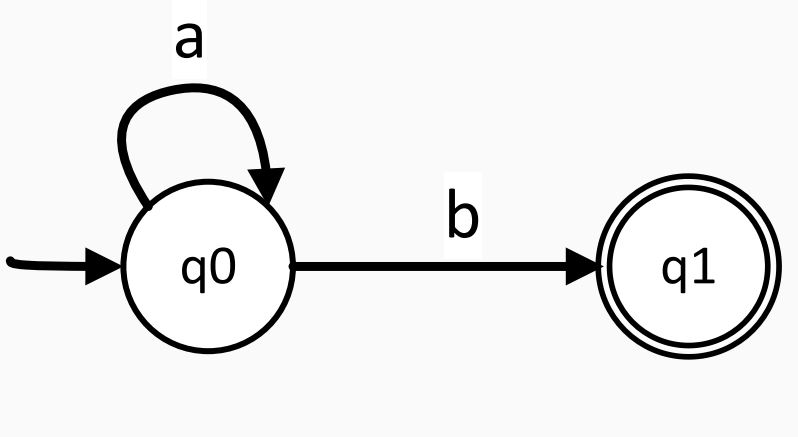Formal Languages and Lexical Analysis

Lexical Analysis Goal
Goal: The primary objective of lexical analysis is to partition an input string into meaningful elements called tokens.
Tasks of Lexical Analyzer: 1. Recognize substrings corresponding to tokens. 2. Return tokens with their categories.
Main Tasks: - Read input characters of the source program. - Group them into lexemes. - Produce, as output, a sequence of tokens for each lexeme in the source program.
Output: - The output of lexical analysis is a stream of tokens, which serves as the input to the parser.
Formal Languages
Definition: - A language over $ Σ $ is a subset of $ Σ $ (set of all words over $ Σ $ ). - Alphabet $ Σ: A $ finite set of elements. - For the lexer: Characters. - For the parser: Token classes/symbol types. - Words (strings): Sequences of elements from the alphabet Σ. - Example: If $ Σ = {𝑎, 𝑏} $, then $ Σ = {\epsilon, 𝑎, 𝑏, 𝑎𝑎, 𝑎𝑏, 𝑏𝑎, 𝑏𝑏, 𝑎𝑎𝑎, 𝑎𝑎𝑏, 𝑎𝑏𝑎, ...} $ - Example of an infinite language over $Σ: 𝐿1 = {𝑎𝑏, 𝑎𝑏𝑎𝑏, 𝑎𝑏𝑎𝑏𝑎𝑏, ...} = {{(𝑎𝑏)}^𝑛 | 𝑛 ≥ 1} $
Formal Languages Description Notations
- Sets: $ 𝐿1 = { {}𝑎^{𝑛} 𝑏 | 𝑛 ≥ 0 } $
- Grammars:
<𝐴> ::= 𝑎𝐴 | 𝑏 - Automata:
- Regular Expressions (Regex): Used only for regular languages.
- Example: 𝑎*
Formal Grammars
Definition: - 𝐺 = {𝑁, Σ, 𝑃, 𝑆}, where - 𝑁: A finite set 𝑁 of nonterminal symbols, disjoint from the strings formed from 𝐺. - Σ: A finite set of terminal symbols, disjoint from 𝑁. - 𝑃: A finite set 𝑃 of production rules, each rule of the form 𝛼 → 𝛽. - 𝑆: A distinguished symbol 𝑆 ∈ 𝑁, the start symbol.
Convention: - Use small letters for terminals and capital letters for non-terminals or variables when writing grammar production rules.
Regular Grammars
Definition: - A grammar 𝐺 = (𝑁, Σ, 𝑃, 𝑆) is right-linear if all productions are of the form: - 𝐴 → 𝑥𝐵 | 𝑥 | 𝜖, where 𝐴, 𝐵 ∈ 𝑁 and 𝑥 ∈ Σ*
Definition: - A grammar is left-linear if all productions are of the form: - 𝐴 → 𝐵𝑥 | 𝑥 | 𝜖, where 𝐴, 𝐵 ∈ 𝑁 and 𝑥 ∈ Σ*
Regular Grammar: - A regular grammar is one that is either right-linear or left-linear.
Deterministic Finite Acceptor (DFA)
Definition:
A deterministic finite acceptor or DFA is defined by the quintuple
$$ [ M = (Q, \Sigma, \delta, q_0, F) ] $$
where
- $( Q )$ is a finite set of internal states,
- $( \Sigma )$ is a finite set of symbols called the input alphabet,
- $( \delta: Q \times \Sigma \rightarrow Q )$ is a total function called the transition function,
- $( q_0 \in Q )$ is the initial state,
- $( F \subseteq Q )$ is a set of final states.
Non-deterministic Finite Acceptor (NFA)
Definition:
A non-deterministic finite acceptor or NFA is defined by the quintuple
$$ [ M = (Q, \Sigma, \delta, q_0, F) ] $$
where
- $( Q )$ is a finite set of internal states,
- $( \Sigma )$ is a finite set of symbols called the input alphabet,
- $( \delta: Q \times (\Sigma \cup {\varepsilon}) \rightarrow 2^Q )$ is a total function called the transition function,
- $( q_0 \in Q )$ is the initial state,
- $( F \subseteq Q )$ is a set of final states.
NFA vs. DFA
DFA Transition Function: $( \delta: Q \times \Sigma \rightarrow Q )$
NFA Transition Function: $( \delta: Q \times (\Sigma \cup {\varepsilon}) \rightarrow 2^Q )$
NFAcan have multiple transitions for one input in a given state.NFAcan have no transition for an input in a given state.NFAcan make a transition without consuming an input symbol (λ or ε-transition).
Computations of a DFA
- For each input string, there is exactly one path in a
DFA(O(n)). $$ [ L(M) = { w \in \Sigma^ : \delta^(q_0, w) \in F } ] $$
Computations of an NFA and Language Acceptance
- For an input string, there are multiple possible computation paths in an
NFA$(O(2^n))$. $$[ L(M) = { w \in \Sigma^ : \delta^(q_0, w) \cap F = \emptyset } ] $$
NFA vs. DFA Implementation
DFAs are generally simpler to implement due to their deterministic nature.NFAs may require additional mechanisms to handle non-deterministic transitions.- Simulation of
NFArequires tracking multiple possible states simultaneously.
